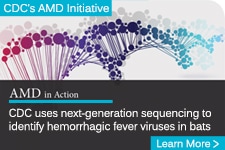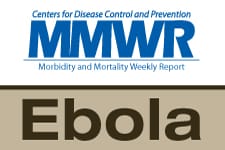Screening Patients
Ebola disease is a rare and deadly viral illness that is reportable to the National Notifiable Disease Surveillance System (NNDSS) in all U.S. states and territories. Healthcare providers should be on alert for and evaluate any patients that are suspected of having Ebola disease.
Ebola Disease Case Definitions
Early recognition of Ebola disease is critical for infection control, given it is spread through person-to-person transmission.
Suspect Case
- Signs and symptoms compatible with Ebola disease.
AND
- An epidemiological risk factor within 21 days (i.e., the incubation period) before the onset of symptoms.
Confirmed Case
Laboratory-confirmed diagnostic evidence of Ebola disease (i.e., through molecular and/or serologic testing).
Evaluating a Patient for Ebola Disease
The majority of febrile patients presenting in U.S. healthcare facilities do not have Ebola disease, but early symptoms of the disease are similar to other febrile illnesses. It is important to systematically assess patients for the possibility of Ebola disease through a triage and evaluation process.
Important questions to ask to begin assessing exposure risk:
- Have you been in contact with a person with suspect or confirmed Ebola disease in the past 21 days (for example touching, caring for, etc.)?
- Have you been to an area with an active Ebola outbreak in the past 21 days? Stay up to date on active travel notices by consulting Ebola and Marburg: Travel information.
Ask about Ebola disease risk factors
Exposure risks for Ebola disease may include the following activities.
- Contact with a symptomatic person with suspected or confirmed Ebola disease, or any objects contaminated by their body fluids
- Experienced a breach in infection prevention and control precautions that result in the potential for contact with body fluids of a patient with suspected or confirmed Ebola disease
- Contact with semen from a person who has recovered from Ebola disease
- Participated in any of the following activities while in an area with an active Ebola disease outbreak:
- Having contact with someone who was sick or died, or any objects contaminated by their body fluids
- Attending/participating in funeral rituals, including preparing bodies for funeral or burial
- Working in a healthcare facility or laboratory
- Visiting a healthcare facility or traditional healer
- Having contact with bats or wild animals
- Working or spending time in a mine/cave
Ebola disease symptoms can appear anywhere from 2 to 21 days after exposure to the virus.
Illness typically progresses from “dry” symptoms (fever, aches, fatigue) to “wet” symptoms (diarrhea, vomiting, and in some cases, bleeding). A person with Ebola disease is not contagious until the appearance of symptoms.
Primary signs and symptoms of Ebola often include some or several of the following:
- Fever (≥100.4°F/38.0°C)
- Aches and pains, such as severe headache and muscle and/or joint pain
- Weakness and fatigue
- Sore throat
- Loss of appetite
- Gastrointestinal symptoms including abdominal pain, diarrhea, and vomiting
- Unexplained hemorrhaging, bleeding or bruising
- Red eyes, skin rash, and hiccups
If Patient Evaluation Indicates Possible Infection with an Ebolavirus, Take Action
If a relevant exposure history is reported AND signs or symptoms are consistent with Ebola disease, take the following steps.
- Isolate the patient in a single room with a private bathroom or a covered bedside commode.
- Adhere to infection prevention and control procedures to prevent transmission through direct or indirect contact, including wearing appropriate PPE and using dedicated equipment.
- Use only essential healthcare workers trained in their designated roles for patient care and keep a log of everyone who enters and leaves the patient’s room.
- Perform only necessary tests and procedures and avoid aerosol-generating procedures.
- Notify your facility’s Infection Prevention and Control Program and other healthcare personnel of a suspect case of Ebola disease.
- Contact the local or state health department for consultation about testing for Ebola disease.
If the patient is not reporting signs and symptoms compatible with Ebola disease but concern remains, consult Local/State Health Department for additional guidance on testing recommendations.
Use these assessment tools to help when evaluating fever, and risk of viral hemorrhagic fevers, in returning travelers.
- Borio L, Inglesby T, Peters CJ, et al: Hemorrhagic fever viruses as biological weapons: Medical and public health management. JAMA 287: 2391–2405, 2002.
- Hsu CH, Champaloux S, Keïta S, et al. Sensitivity and Specificity of Suspected Case Definition Used during West Africa Ebola Epidemic [PDF – 408 KB – 16 pages]. Emerg Infect Dis. 2018 Jan; 24(1): 9–14.

